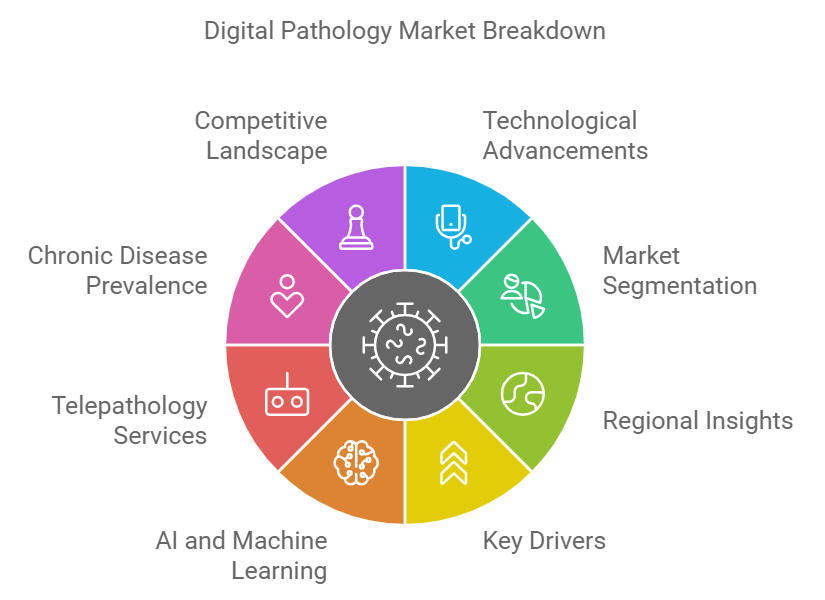Introduction
The global digital pathology market is undergoing rapid growth, driven by increasing adoption of advanced diagnostic technologies, a surge in the prevalence of chronic diseases, and the integration of artificial intelligence (AI) and machine learning (ML) into healthcare workflows. As of 2023, the market was valued at $884.4 million, with an anticipated compound annual growth rate (CAGR) of 12.2% projected to push the market size to nearly $12 billion by 2030. This explosive growth presents lucrative opportunities for stakeholders, including healthcare providers, pharmaceutical companies, and technology developers, who are keen to leverage digital pathology to enhance diagnostic precision and operational efficiency.

Market Overview
Current Market Size and Growth Projections
The digital pathology market’s current valuation of $884.4 million in 2023 represents a significant leap from previous years, with projections indicating a surge to nearly $12 billion by 2030. This expansion is underpinned by several factors, including:
- Technological advancements: The continuous evolution of AI-based diagnostic tools, automated scanners, and cloud-based platforms that facilitate rapid image analysis and data sharing.
- Increasing adoption in clinical settings: More hospitals and laboratories are implementing digital pathology solutions to improve diagnostic accuracy, reduce turnaround time, and optimize treatment planning.
With a CAGR of 12.2% forecasted from 2023 to 2030, the digital pathology market is set to outpace many other segments within the broader medical imaging and diagnostics industry, positioning itself as a cornerstone of modern healthcare infrastructure.
Role of AI and Machine Learning in Digital Pathology
The integration of AI and ML has revolutionized the digital pathology landscape, offering capabilities such as:
- Automated image analysis: Using machine learning algorithms to quickly detect patterns and abnormalities in pathology slides.
- Enhanced diagnostic accuracy: AI-powered tools help pathologists identify subtle changes that may be missed by human eyes, thus improving disease detection rates, particularly in oncology.
- Workflow optimization: ML models streamline workflow by prioritizing cases based on urgency, reducing the burden on pathologists and allowing for faster patient management.

Key Drivers of Market Growth
Technological Advancements in Digital Pathology
- The digital pathology market is heavily driven by innovations in AI, image analysis software, and telepathology solutions. Notable advancements include:
- Automated slide scanners that digitize traditional microscope slides into high-resolution images for easier sharing and analysis.
- Pattern recognition algorithms that aid in the identification of cancerous cells, tissue abnormalities, and other diagnostic markers with unprecedented speed and accuracy.
- Cloud computing and big data: These technologies facilitate the storage and analysis of vast amounts of diagnostic data, enabling collaborative research and remote diagnostics.
Rising Incidence of Chronic Diseases
- With chronic diseases such as cancer, cardiovascular diseases, and diabetes becoming more prevalent globally, the need for efficient diagnostic tools is greater than ever.
- Cancer diagnosis, in particular, has been a significant driver, with digital pathology playing a crucial role in enabling early detection and personalized treatment. The ability to share digital slides with experts across geographies for a second opinion improves diagnostic outcomes and accelerates treatment decisions.
Expansion of Telepathology and Remote Diagnostic Services
- Telepathology services are expanding rapidly, allowing pathologists to perform remote consultations and review cases from anywhere in the world. This not only addresses the shortage of skilled pathologists in certain regions but also improves access to quality diagnostic services.
- The implementation of telepathology has proven particularly beneficial in rural and underserved areas, where access to specialized pathology expertise is limited. The availability of digital tools ensures that even patients in remote locations receive timely and accurate diagnoses.
Market Segmentation Analysis
By Application
- Human Pathology:
- The human pathology segment dominates the digital pathology market, accounting for the majority of the market share. This is driven by the increasing demand for accurate diagnostic solutions in oncology, cardiology, and neurology.
- Clinical diagnosis and treatment planning benefit greatly from digital pathology’s ability to deliver precise and rapid results.
- Drug Discovery and Development:
- Digital pathology is becoming indispensable in pharmaceutical research. The ability to analyze large datasets efficiently speeds up the drug discovery process, enabling quicker identification of potential drug candidates.
- This application is especially relevant in cancer research, where digital pathology helps in the examination of biomarker expressions and tumor microenvironment analysis.
By Product Type
- Scanners:
- Digital slide scanners are essential tools in digital pathology, converting traditional slides into digital formats for analysis. Innovations in scanner technology, such as high-speed scanning and 3D imaging capabilities, continue to drive growth.
- Software Solutions:
- The market for image analysis software is expanding rapidly, with vendors offering AI-powered tools that automate complex tasks such as cell segmentation and tissue quantification.
- Data management software for organizing, storing, and sharing pathology data across healthcare networks is becoming increasingly important, particularly in large hospital systems.
- Storage Solutions:
- As digital pathology generates large quantities of data, cloud-based storage solutions are gaining traction due to their scalability and collaborative features. They provide secure data management while ensuring compliance with healthcare regulations.
By End-User
- Hospitals and Diagnostic Laboratories:
- Hospitals are the largest end-users, as they handle large volumes of pathology cases and benefit from the integration of digital pathology into routine diagnostics.
- Diagnostic laboratories also utilize digital tools for biopsy analysis, tumor grading, and molecular pathology.
- Academic and Research Institutes:
- These institutes leverage digital pathology for teaching, training, and research purposes. The ability to share slides globally enhances collaborative research and accelerates medical breakthroughs.
Regional Market Insights
North America
- North America leads the global digital pathology market, accounting for the largest revenue share due to:
- Advanced healthcare infrastructure: The presence of state-of-the-art hospitals and diagnostic laboratories.
- Significant investments in healthcare technology: Strong focus on R&D and government funding for healthcare innovation.
- United States: The primary market in the region, with a well-established network of academic institutions and research centers that are early adopters of digital pathology tools.
Europe
- The European digital pathology market is poised for substantial growth, driven by:
- The adoption of AI-based diagnostic tools in clinical settings.
- Regulatory policies supporting digital health initiatives, such as the European Health Data Space.
- Countries like Germany, UK, and France are at the forefront, with increasing investments in healthcare digitalization and AI research.
Asia Pacific
- Asia Pacific is expected to grow at the fastest rate during the forecast period due to:
- Rising healthcare investments: Countries like China, India, and Japan are making significant investments in upgrading their healthcare infrastructure.
- Increasing prevalence of chronic diseases: Growing incidence of conditions such as cancer, which requires advanced diagnostic solutions.
- Digitalization efforts in healthcare systems across Southeast Asia and Oceania further drive the adoption of digital pathology.
Competitive Landscape
Key Players in the Market
- Major companies in the digital pathology market include:
- Fujifilm Holdings Corporation: Leveraging its imaging expertise to offer advanced digital pathology solutions.
- Danaher Corporation: Through subsidiaries like Leica Biosystems, Danaher is a key player in pathology imaging.
- Koninklijke Philips N.V.: Offering a comprehensive suite of digital pathology and diagnostic imaging solutions.
- Roche Diagnostics: Focused on integrating digital pathology with molecular diagnostics for a comprehensive approach to cancer diagnosis.
- PathAI: A leader in AI-powered pathology solutions, continuously advancing algorithms for better diagnostic precision.
Competitive Strategies and Innovations
- Companies are deploying various strategies to stay ahead in the market, including:
- Developing integrated software solutions: Aimed at enhancing laboratory efficiency and diagnostic accuracy.
- Collaborating with technology firms: To integrate AI and cloud-based technologies into their products.
- Expanding product portfolios through acquisitions: For example, acquiring startups that specialize in niche areas like image analysis algorithms or telepathology solutions.
Regulatory Environment and Market Opportunities
Evolving Regulatory Landscape
- The regulatory environment for digital pathology is becoming increasingly favorable, with:
- FDA approvals for digital slide systems and AI-based diagnostic tools.
- Government initiatives to promote digital health adoption, such as funding for research and development.
- Compliance requirements: Emphasizing the importance of data privacy and cybersecurity in handling patient information.
Opportunities for New Entrants and Market Expansion
- Startups and new players have significant opportunities to enter the market, particularly by focusing on:
- Niche segments, such as AI-driven pathology software.
- Emerging markets: Expanding into regions like Latin America and Middle East & Africa, where digital pathology is still in its early stages.
Challenges in the Digital Pathology Market
High Costs and Budget Constraints
- While digital pathology offers numerous benefits, the initial investment in scanners, software, and training can be prohibitive for some institutions, particularly in developing economies.
Data Privacy and Security Concerns
- The need for stringent data protection measures arises due to the large amounts of sensitive patient information generated by digital pathology. Compliance with regulations such as HIPAA and the GDPR is essential.
Future Outlook and Trends
Integration of AI-Powered Tools
- AI in digital pathology will continue to evolve, with innovations in deep learning models that can assist in predictive analytics and personalized medicine.
Shift Towards Personalized Medicine
- As the demand for precision medicine grows, digital pathology’s role in biomarker analysis and molecular diagnostics will expand.
Expansion of Cloud-Based Solutions
- Cloud-based pathology platforms are expected to see increased adoption due to their ability to facilitate real-time collaboration and remote diagnostics.
Conclusion
The digital pathology market is set to experience unprecedented growth, reaching nearly $12 billion by 2030. Key drivers such as technological advancements, increasing chronic disease prevalence, and expansion of telepathology services are shaping the future of the market. Stakeholders must capitalize on the evolving trends by integrating AI technologies and focusing on collaborative approaches to remain competitive in this rapidly growing industry.
Citations:
[1] https://www.persistencemarketresearch.com/market-research/digital-pathology-market.asp
[3] https://www.grandviewresearch.com/industry-analysis/digital-pathology-systems-market
[4] https://www.marketsandmarkets.com/Market-Reports/digital-pathology-market-844.html
[5] https://media.market.us/digital-pathology-market-news/
[6] https://www.insightaceanalytic.com/report/digital-pathology-market/1629
[7] https://www.futuremarketinsights.com/reports/global-digital-pathology-market
Latest Posts:
- Recycling Water Filtration Market to Hit $3.06 Billion by 2024: Key Drivers Behind the Rapid Growth
- $474 Million in Damages: How Will Hurricanes Impact Future Property Values?
- Tapping into the $6.94 Billion Neuro-Endocrine Tumor Market: Is This the Next Groundbreaking Investment Opportunity?
- Future Market Value: $7.8 Billion by 2030 | Is the Surgical Sutures Market Set for Explosive Growth?
- The Promising Future of the Global Two-Wheeler Catalytic Converter Market: Trends and Projections for 2024-2028

